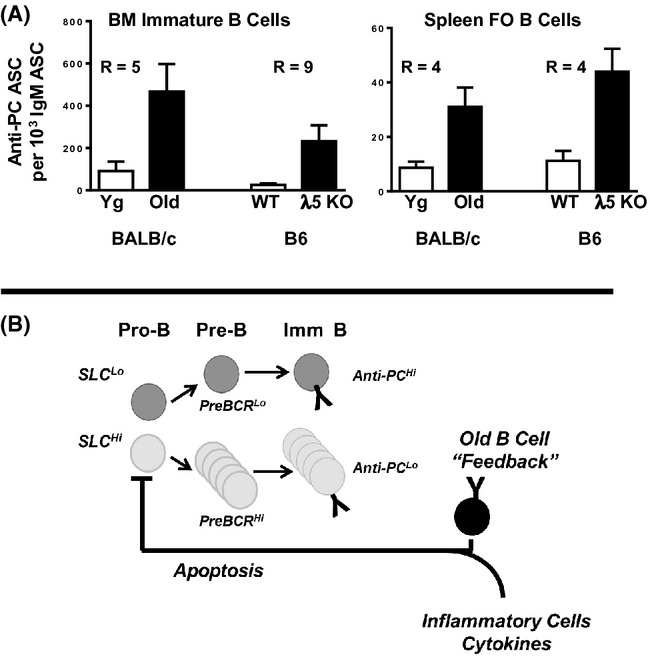Fig 6.

Deficiency in λ5 expression in old and young mice increases B-cell reactivity to phosphorylcholine. (A) Immature bone marrow B cells and splenic follicular (FO) B cells from young and aged BALB/c mice were cultured with lipopolysaccharide (LPS) and antibody-secreting cells (ASC) were assayed by ELISpot on phosphorylcholine (PC)-BSA and anti-μ coated plates as per Experimental Procedures. For BALB/c immature B cells, N = 6 young and 10 old mice; for BALB/c FO B cells, N = 11 young and 10 old mice. The extent of pre-B-cell loss in the old BALB/c mice used ranged from 11% to 76% (average, 59% ± 7% SEM), where four of the ten mice were severely depleted of pre-B cells (72–76%). Similarly, bone marrow B cells and splenic FO B cells were isolated from young adult λ5 KO and wild-type mice, LPS stimulated, and PC-reactive ASC determined. For bone marrow λ5 KO B cells, N = 11; for wild-type B cells, N = 10; for λ5 KO FO B cells and wild-type FO B cell groups, N = 3 and 4, respectively. R values shown are the ratio of the two groups indicated. P values between each pair of groups were all <0.03 using Mann–Whitney U-test and/or Student's t-test (with Welch's correction). (B) In our model, ‘pro-inflammatory’ conditions in old bone marrow, including an increase in TNFα-producing B cells, promote the apoptotic death of pro-B cells in the bone marrow. However, as pro-B cells that undergo cytokine-induced apoptosis are relatively high in surrogate light chain (SLC), this negative selection results in a reduced pro-B-cell pool with relatively low SLC expression. When B-cell precursors are ‘SLClow’, those new B cells which develop in bone marrow and which go on to populate the spleen show enhanced expression of autoreactive anti-PC antibodies.
